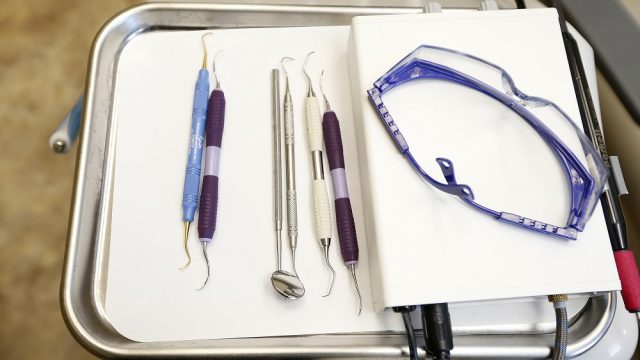Michael Hamilton: Dental Therapists Would Fill North Dakota’s Care Cavity

Dental tools. Jesse Trelstad/ Grand Forks Herald
North Dakota’s dentistry laws have a cavity legislators can easily fill in 2017. State lawmakers should seize the opportunity this legislative session to expand access to oral health care for underserved patients by allowing dentists to hire midlevel practitioners termed “dental therapists.” They can do this by passing House Bill 1256.
More than 66,000 North Dakotans, almost 10 percent of the state’s population, live in 35 regions the federal Health Resources & Services Administration recognizes as dental health professional shortage areas.”
Approximately 37,000 out of 51,000 North Dakota children eligible for Medicaid, or 72 percent, did not receive preventive dental care in 2015, and 65 percent of children on Medicaid “went without any dental or oral health service,” according to research by the Center for Rural Health at the University of North Dakota School of Medicine & Health Sciences.
Among the elderly, two-thirds of nursing home residents with “total tooth loss” in 2016 were on Medicaid, and more than one-third of North Dakotans aged 65 or older with teeth needed “early or urgent care” in 2016, the Center found. Nevertheless, just 7 percent of long-term care (LTC) facilities responding to a 2015 survey said an oral health care professional conducts residents’ initial oral health exam.
If the current supply of oral health professionals were adequate for filling North Dakota’s shortages under the state’s Medicaid reimbursement levels, shortages would not persist.
Lawmakers can and should allow an additional proven, well-trained, cost-effective oral care professional to enter the market: dental therapists.
[mks_pullquote align=”left” width=”300″ size=”24″ bg_color=”#ffffff” txt_color=”#000000″]Some would have North Dakota lawmakers preserve the status quo by refusing to let dental therapists obtain licenses in the state. Their objections universally fall short of justifying the current blockade of dental therapy[/mks_pullquote]
Dental therapists are dental team members who practice alongside dental hygienists and dental assistants under the supervision of licensed dentists who choose to employ them.
Dental therapists typically perform services and procedures oral hygienists and dental assistants cannot, such as certain extractions and fillings. These procedures are important to preventing oral health disease, which can lead to other serious health problems if left unaddressed.
Because dentists train for a broader and highly technical procedures, dental therapists’ narrower scope of practice allows them to do certain procedures more times than dentists during their training programs. Dental therapists also cost less to employ, earning 50–60 percent of what dentists earn.
Consequently, dentists in Minnesota, which authorized dental therapy in 2009, are treating greater volumes of Medicaid patients even though Medicaid compensates dentists less than private insurance. In Alaska, whose Alaska Native Tribal Health Consortium established the first dental therapy program in the United States, dental therapists have been helping expand oral care to underserved patients since 2003. Maine approved dental therapy in 2014, and Vermont approved dental therapy in 2016.
Some would have North Dakota lawmakers preserve the status quo by refusing to let dental therapists obtain licenses in the state. Their objections universally fall short of justifying the current blockade of dental therapy, rights of enterprising dentists, and treatment of underserved patients.
“The Case for Licensing Dental Therapists in North Dakota,” a new policy brief published by The Heartland Institute and Texas Public Policy Foundation in January 2017, refutes pet objections to dental therapy.
For instance, one Minnesota dentist told North Dakota lawmakers in September 2016 he was disappointed in the training of the dental therapist he hired. The Heartland brief quotes at length a little-publicized letter from a different dentist who hired the same dental therapist and said he “has done an excellent job … effectively [caring] for our patients.”
Also unfounded are fears dental therapists would practice in regions glutted with providers. In Minnesota, 48 percent of dental therapists practice in rural areas, where less than 48 percent of Minnesotans live, thus disproportionally benefitting rural residents prone to shortages.
Dental therapists will not, as some say, lead to a “two-tiered system” of care and quality, because dentists would remain fully responsible for the quality of care their employees give. Blocking dental therapy, however, would preserve a two-tiered system of “haves” and “have nots.”
No dentist would be forced to hire a dental therapist, and authorizing dental therapy would not prevent dentists from pursuing other options simultaneously. Lawmakers should pass House Bill 1256 now to make dental therapists available to dentists, freeing dentists to hire therapists if they wish, just as dentists who do not want to hire them are free.




